Excerpts from Jim Conrad's
Naturalist Newsletter
entry from field notes dated July 2, 2022, taken on Cerro de la Cruz, at an elevation of ~2885m (~9465 ft), just south of the community of El Pinar, Amealco de Bonfil, Querétaro, MÉXICO, (~N20.17°, ~W100.17°)
"CALIFORNIA LILAC"
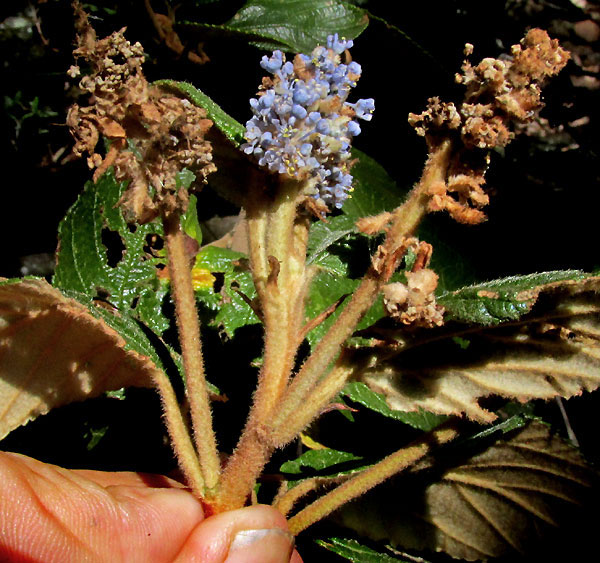
On the lower, eastern slope of Cerro de la Cruz, a spindly woody shrub or small tree a little over head tall grew beside a trail through the droughty oak woods. A few of its dusty branches were tipped with flower clusters like those seen above. Many clusters were composed of just brown, dried-up flowers. The rainy season hasn't come this year when it should have, so maybe that explained it. Still, a few branches bore flowers enabling a closer look:
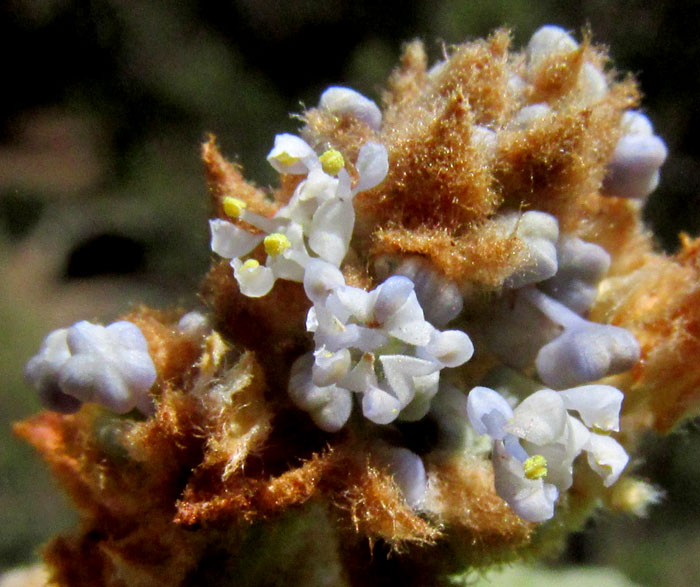
Individual flowers were too tiny for my poor vision to register details in the field but, later on the computer screen, this became clear: Each blossom bore 5 slender, pale blue petals not connected with one another at their bases; the 5 sepals were twice the width of the petals and pleated down their backs, and of the same pale blue hue as the petals, and; each flower produced 5 stamens, though mostly they were hidden by the petals.
At first these features were disheartening because this 5-5-5 formula is the basic pattern seen in many species in many plant families. However, then something special was noticed, especially well seen in a flower at about 10 o'clock from the center of the above flower cluster: The stamens with their yellow anthers are actually surrounded, or "hooded," by the petals. Not only that, but the stamens arise in front of the petals, not between them. Only a handful of plant families put their stamens in front of their petals.
We've seen flowers like this before, for instance on Deer Brush up in Oregon, also with pale blue flowers aggregated into racemelike inflorescences on woody branches of bushes or small trees. Deer Brush belongs to the often-thorny Buckthorn Family, the Rhamnaceae. Moreover, in the Yucatán we've seen the Coffee Colubrina, with stems and leaf undersurfaces heavily coated with short, rusty-colored hairs as seen on this plant. "Buckthorn Family," these flowers said, though our plant bore no thorns or spines, like most species in that family.
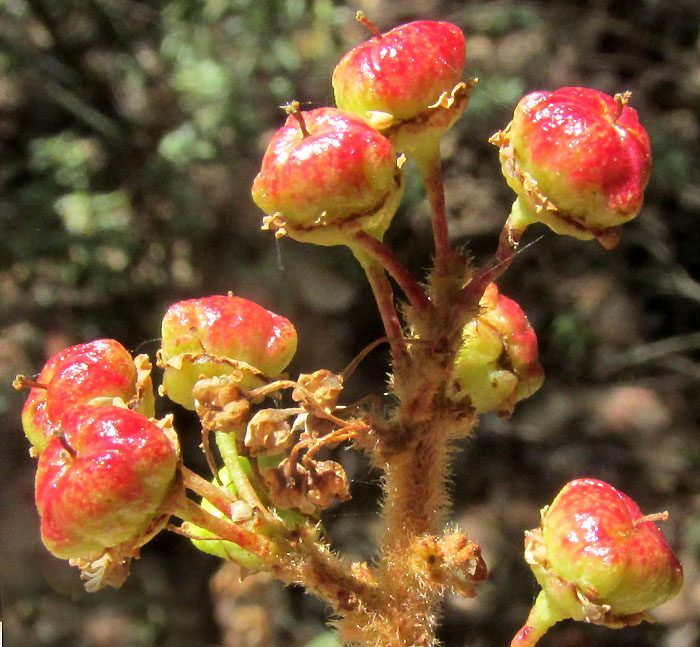
One branch bore the above fruits, which technically are described as capsules, meaning that they're simple, dry fruits which split open to release seeds when mature. The fruits as they appear above suggest a fleshy fruit that won't split open, but the literature assures us that when mature they'll be capsules with leathery coverings that slough off before the fruits split.
The little tree's leaves, which alternated on stems, were sawtooth-margined, or serrate, as shown below:

Dense hairs on the undersurfaces of young leaves and stems included branched, or stellate, ones and they were reddish brown, or ferruginous:
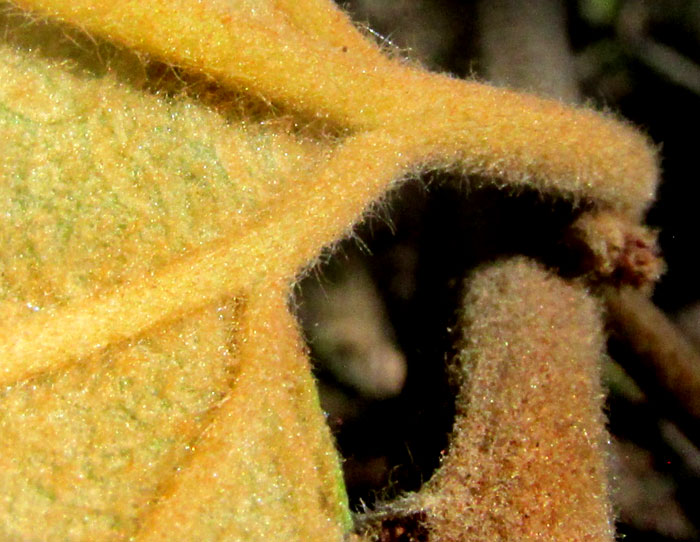
Finally, here's what our little tree or bush looked like along the trail through the oak forest:
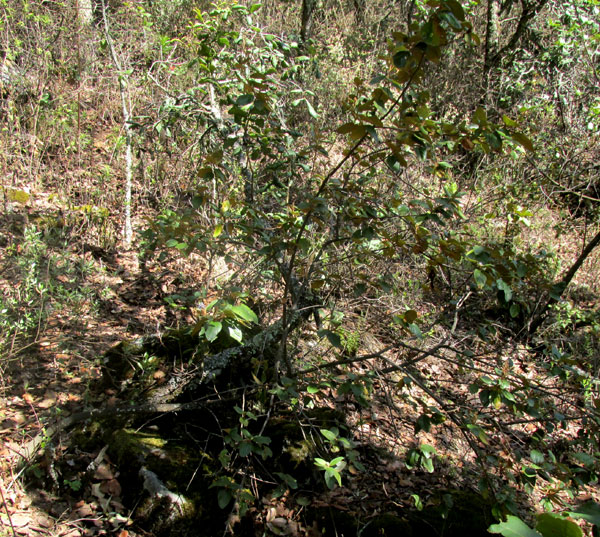
Using the Buckthorn Family volume of the Flora del Bajío, which covers this region of upland central Mexico, it was easy enough to identify our plant at CEANOTHUS CAERULEUS, occurring in mountainous oak and pine forests, and disturbed areas, at elevations from 1800-3200 meters (5900-10,500 feet), throughout Mexico and in Guatemala. In English it's known as the "California Lilac," because various cultivars of the species have been commercialized under that name. I use quotation marks around the name because it's not native to California and it's unrelated to the lilacs. "California Lilac" is considered an uncommonly grown garden species, pretty when taken care of, but vulnerable to cold temperatures. However, numerous hybrids have been based on it, especially the "French" hybrids, like Ceanothus x delilianus, developed by French breeders during the 1800s. Over 200 named horticultural cultivars are recognized.
"California Lilac" is an especially valuable citizen of the habitats it favors because its roots bear nodules containing fungal mycorrhizae which "fix" nitrogen needed by the tree and other members of the community. This has been documented by H. Ramírez-Saad in his 1998 study "Root nodules of Ceanothus caeruleus contain both the N2-fixing Frankia endophyte and a phylogenetically related Nod-/Fix-actinomycete."
The Flora of North America reports that hybridization is widespread in the genus Ceanothus, and that certain hybrids experience high levels of sterility. I thought about that when noticing that in the second from the top picture on this page all but one flower seemed to lack a pistil, the female part. It was the same in other pictures not used here.
Well, every organism I pay attention to encourages questions like that. The more I know, the more slippery and mysterious the whole thing becomes.